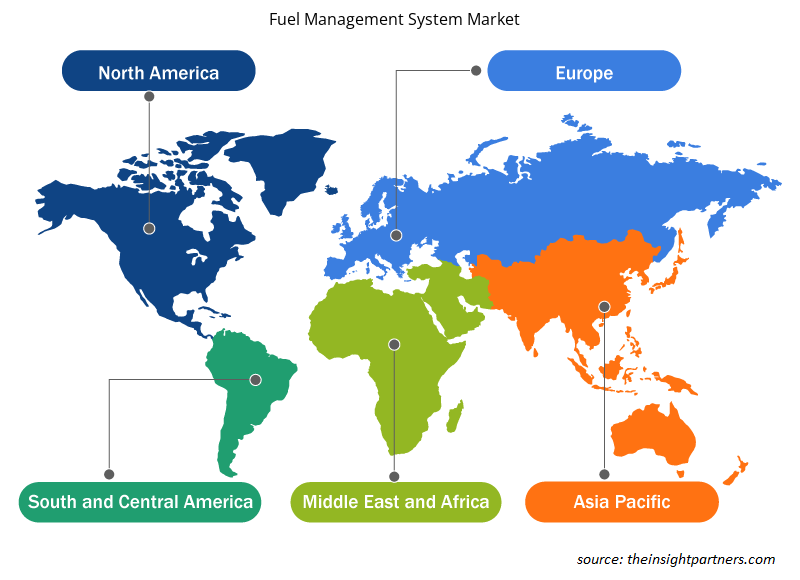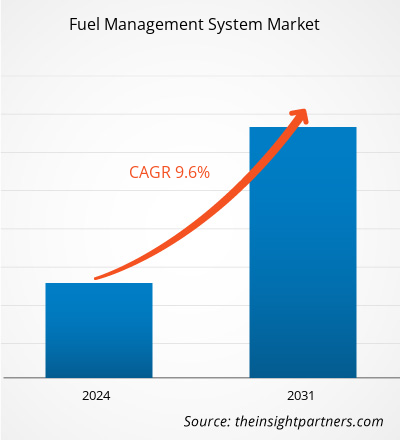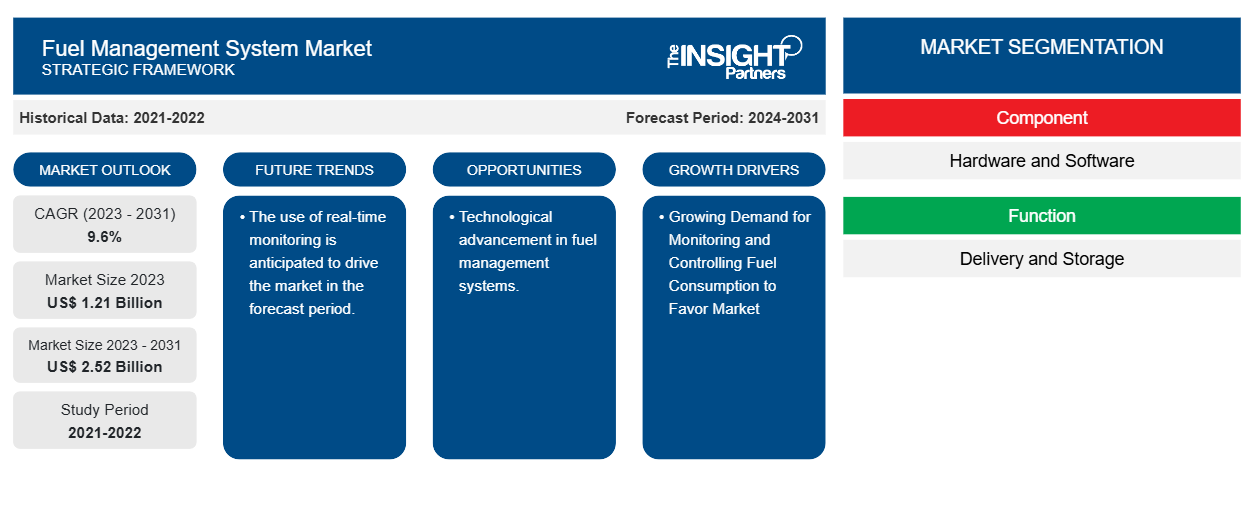من المتوقع أن يصل حجم سوق نظام إدارة الوقود إلى 2.52 مليار دولار أمريكي بحلول عام 2031 من 1.21 مليار دولار أمريكي في عام 2023. ومن المتوقع أن يسجل السوق معدل نمو سنوي مركب بنسبة 9.8٪ خلال الفترة 2023-2031. ومن المرجح أن يظل الطلب المتزايد على مراقبة ومراقبة استهلاك الوقود وزيادة حالات سرقة الوقود من الاتجاهات الرئيسية في السوق.CAGR of 9.8% during 2023–2031. Increasing demand for monitoring and controlling fuel consumption and increasing cases of fuel theft are likely to remain key trends in the market.
تحليل سوق نظام إدارة الوقود
من المتوقع أن ينمو الطلب على سوق أنظمة إدارة الوقود مع الحاجة المتزايدة إلى إدارة أفضل للوقود لتحسين الإنتاجية والكفاءة في العديد من الصناعات. علاوة على ذلك، أدى النمو السريع لمنصات التجارة الإلكترونية لتقديم تجربة أفضل للعملاء إلى دفع صناعات التوريد والخدمات اللوجستية إلى تعزيز صناعات إنترنت الأشياء.
نظرة عامة على سوق نظام إدارة الوقود
نظام إدارة الوقود هو نوع من تكنولوجيا البرمجيات والأجهزة المستخدمة لمراقبة استهلاك الوقود والتحكم فيه وتحسينه في تطبيقات مختلفة، مثل صناعات النقل والبناء والطاقة. في المركبات، يمكن أن تساعد أنظمة إدارة الوقود في ضمان استخدام الوقود بكفاءة من خلال مراقبة استهلاك الوقود وأداء المحرك وعوامل أخرى. يمكن أن يساعد هذا في تقليل تكاليف الوقود وزيادة الكفاءة التشغيلية وخفض الانبعاثات.
قم بتخصيص هذا التقرير ليناسب متطلباتك
ستحصل على تخصيص لأي تقرير - مجانًا - بما في ذلك أجزاء من هذا التقرير، أو تحليل على مستوى الدولة، وحزمة بيانات Excel، بالإضافة إلى الاستفادة من العروض والخصومات الرائعة للشركات الناشئة والجامعات
-
احصل على أهم اتجاهات السوق الرئيسية لهذا التقرير.ستتضمن هذه العينة المجانية تحليلاً للبيانات، بدءًا من اتجاهات السوق وحتى التقديرات والتوقعات.
محركات وفرص سوق نظام إدارة الوقود
تزايد الطلب على مراقبة ومراقبة استهلاك الوقود لصالح السوق
إن الطلب المتزايد على مراقبة استهلاك الوقود والتحكم فيه هو المحرك لسوق أنظمة إدارة الوقود، حيث توجد العديد من الفوائد لمراقبة استهلاك الوقود. فوائد مثل توفير التكاليف، وتحديد عدم الكفاءة، والحد من الانبعاثات، وما إلى ذلك. بالإضافة إلى ذلك، فإن الطلب على مراقبة استهلاك الوقود في الوقت الفعلي يتزايد أيضًا. فهو يمكّن الشركات من تحديد ومعالجة هدر الوقود فور حدوثه وليس بعد وقوعه. يمكن أن يساعد هذا الشركات على تقليل استهلاك الوقود والتكاليف في الوقت الفعلي، مما قد يكون له تأثير كبير على صافي أرباحها. بالنظر إلى الفوائد العديدة لمراقبة استهلاك الوقود والتحكم فيه، فإن نظام إدارة الوقود مطلوب.
التقدم التكنولوجي في أنظمة إدارة الوقود.
يحمل التقدم التكنولوجي في أنظمة إدارة الوقود العديد من الفرص. التطورات التكنولوجية مثل تكامل إنترنت الأشياء، والتحليلات التنبؤية، وخوارزميات التعلم الآلي، والبلوك تشين للشفافية، والمركبات الموفرة للطاقة ، وما إلى ذلك. يمكن أن تساعد هذه التطورات العديد من الصناعات، بما في ذلك الخدمات اللوجستية والنقل، والتصنيع وسلسلة التوريد، والزراعة، والبناء، وإدارة الأسطول والخدمات، وما إلى ذلك. وبالتالي، فإن التقدم التكنولوجي في مختلف الصناعات يزيد من الطلب على أنظمة إدارة الوقود.IoT integration, predictive analytics, machine learning algorithms, blockchain for transparency, energy-efficient
تقرير تحليل تجزئة سوق نظام إدارة الوقود
إن القطاعات الرئيسية التي ساهمت في اشتقاق تحليل سوق نظام إدارة الوقود هي المكون والوظيفة والمستخدم النهائي.
- بناءً على المكون، ينقسم سوق نظام إدارة الوقود إلى أجهزة وبرامج. ومن المتوقع أن يحظى قطاع البرامج بحصة سوقية كبيرة خلال فترة التوقعات.
- بناءً على الوظيفة، ينقسم سوق نظام إدارة الوقود إلى قسمي التوصيل والتخزين. ومن المتوقع أن يحظى قطاع التوصيل بحصة سوقية كبيرة خلال الفترة المتوقعة.
- بحسب المستخدم النهائي، يتم تقسيم السوق إلى التعدين والبناء والموانئ والنقل والخدمات اللوجستية والنفط والغاز وغيرها. ومن المتوقع أن يحظى قطاع التعدين بحصة سوقية كبيرة خلال الفترة المتوقعة.
تحليل حصة سوق نظام إدارة الوقود حسب المنطقة الجغرافية
ينقسم النطاق الجغرافي لتقرير سوق نظام إدارة الوقود بشكل أساسي إلى خمس مناطق: أمريكا الشمالية، ومنطقة آسيا والمحيط الهادئ، وأوروبا، والشرق الأوسط وأفريقيا، وأمريكا الجنوبية والوسطى.
سيطرت أمريكا الشمالية على سوق أنظمة إدارة الوقود. وقد أدت اتجاهات تبني التكنولوجيا العالية في مختلف الصناعات في منطقة أمريكا الشمالية إلى تغذية نمو سوق أنظمة إدارة الوقود. ومن المتوقع أن تؤدي عوامل مثل زيادة اعتماد الأدوات الرقمية والإنفاق التكنولوجي العالي من قبل الوكالات الحكومية إلى دفع نمو سوق أنظمة إدارة الوقود في أمريكا الشمالية. علاوة على ذلك، فإن التركيز القوي على البحث والتطوير في الاقتصادات المتقدمة في الولايات المتحدة وكندا يجبر اللاعبين في أمريكا الشمالية على جلب حلول متقدمة تقنيًا إلى السوق. بالإضافة إلى ذلك، يوجد في الولايات المتحدة العديد من اللاعبين في سوق أنظمة إدارة الوقود الذين يركزون بشكل متزايد على تطوير حلول مبتكرة. كل هذه العوامل تساهم في نمو سوق أنظمة إدارة الوقود في المنطقة.fuelled the growth of the fuel management system market. Factors such as increased adoption of digital tools and high technological spending by government agencies are expected to drive the North American fuel management system market growth. Moreover, a strong emphasis on research and development in the developed economies of the US and Canada is forcing the North American players to bring technologically advanced solutions into the market. In addition, the US has many fuel management system market players who have been increasingly focusing on developing innovative solutions. All these factors contribute to the region's growth of the fuel management system market.
رؤى إقليمية حول سوق أنظمة إدارة الوقود
لقد قام المحللون في Insight Partners بشرح الاتجاهات والعوامل الإقليمية المؤثرة على سوق نظام إدارة الوقود طوال فترة التوقعات بشكل شامل. يناقش هذا القسم أيضًا قطاعات سوق نظام إدارة الوقود والجغرافيا في جميع أنحاء أمريكا الشمالية وأوروبا ومنطقة آسيا والمحيط الهادئ والشرق الأوسط وأفريقيا وأمريكا الجنوبية والوسطى.

- احصل على البيانات الإقليمية المحددة لسوق نظام إدارة الوقود
نطاق تقرير سوق نظام إدارة الوقود
| سمة التقرير | تفاصيل |
|---|---|
| حجم السوق في عام 2023 | 1.21 مليار دولار أمريكي |
| حجم السوق بحلول عام 2031 | 2.52 مليار دولار أمريكي |
| معدل النمو السنوي المركب العالمي (2023 - 2031) | 9.6% |
| البيانات التاريخية | 2021-2022 |
| فترة التنبؤ | 2024-2031 |
| القطاعات المغطاة |
حسب المكون
|
| المناطق والدول المغطاة |
أمريكا الشمالية
|
| قادة السوق وملفات تعريف الشركات الرئيسية |
|
كثافة اللاعبين في سوق أنظمة إدارة الوقود: فهم تأثيرها على ديناميكيات الأعمال
يشهد سوق أنظمة إدارة الوقود نموًا سريعًا، مدفوعًا بالطلب المتزايد من المستخدم النهائي بسبب عوامل مثل تفضيلات المستهلكين المتطورة والتقدم التكنولوجي والوعي المتزايد بفوائد المنتج. ومع ارتفاع الطلب، تعمل الشركات على توسيع عروضها والابتكار لتلبية احتياجات المستهلكين والاستفادة من الاتجاهات الناشئة، مما يؤدي إلى زيادة نمو السوق.
تشير كثافة اللاعبين في السوق إلى توزيع الشركات أو المؤسسات العاملة في سوق أو صناعة معينة. وهي تشير إلى عدد المنافسين (اللاعبين في السوق) الموجودين في مساحة سوق معينة نسبة إلى حجمها أو قيمتها السوقية الإجمالية.
الشركات الرئيسية العاملة في سوق نظام إدارة الوقود هي:
- حلول أسطول شيڤين
- فرانكلين الكتريك
- شركة جيلباركو
- شركة مولتيفورس سيستمز.
- الملاحة 8
- شركة بيوسي
إخلاء المسؤولية : الشركات المذكورة أعلاه ليست مرتبة بأي ترتيب معين.

- احصل على نظرة عامة على أهم اللاعبين الرئيسيين في سوق نظام إدارة الوقود
أخبار سوق أنظمة إدارة الوقود والتطورات الأخيرة
يتم تقييم سوق نظام إدارة الوقود من خلال جمع البيانات النوعية والكمية بعد البحث الأولي والثانوي، والتي تتضمن منشورات الشركات المهمة وبيانات الجمعيات وقواعد البيانات. فيما يلي بعض التطورات في سوق نظام إدارة الوقود:
- أقامت شركة Kongsberg Digital شراكة مع شركة Royston لتقديم نظام إلكتروني لإدارة الوقود. ستمكن هذه الشراكة أصحاب السفن من تحسين استهلاك الوقود وتعزيز الشفافية وتعزيز إزالة الكربون من عمليات السفن من خلال الجمع بين Vessel Insight من شركة Kongsberg Digital ونظام Enginei الإلكتروني لإدارة الوقود من شركة Royston. (المصدر: Royston، موقع شركة Press Company، فبراير 2024)
- أصبحت شركة إيرباص شريكًا استراتيجيًا لشركة DG Fuels, LLC ("DGF")، وهي شركة رائدة ناشئة في مجال وقود الطيران المستدام. يعتمد نظام إنتاج الوقود الخاص بشركة DGF بالكامل على منتجات النفايات السليلوزية، مثل نفايات الخشب من صناعة قطع الأشجار، ومصادر الطاقة المتجددة، مثل طاقة الرياح والطاقة الشمسية. (المصدر: موقع شركة إيرباص على الإنترنت، سبتمبر 2023)
تقرير سوق نظام إدارة الوقود والتغطية والنتائج المتوقعة
يقدم تقرير "حجم سوق نظام إدارة الوقود والتوقعات (2021-2031)" تحليلاً مفصلاً للسوق يغطي المجالات التالية:
- حجم سوق نظام إدارة الوقود وتوقعاته على المستويات العالمية والإقليمية والوطنية لجميع قطاعات السوق الرئيسية المشمولة بالنطاق.
- اتجاهات سوق نظام إدارة الوقود بالإضافة إلى ديناميكيات السوق مثل المحركات والقيود والفرص الرئيسية.
- تحليل مفصل لقوى PEST/Porter الخمس وSWOT
- تحليل سوق نظام إدارة الوقود يغطي اتجاهات السوق الرئيسية والإطار العالمي والإقليمي واللاعبين الرئيسيين واللوائح والتطورات الأخيرة في السوق.
- تحليل المشهد الصناعي والمنافسة الذي يغطي تركيز السوق، وتحليل خريطة الحرارة، واللاعبين البارزين، والتطورات الأخيرة في سوق نظام إدارة الوقود.
- ملفات تعريفية مفصلة للشركة.
- التحليل التاريخي (سنتان)، سنة الأساس، التوقعات (7 سنوات) مع معدل النمو السنوي المركب
- تحليل PEST و SWOT
- حجم السوق والقيمة / الحجم - عالمي، إقليمي، بلد
- الصناعة والمنافسة
- مجموعة بيانات إكسل
التقارير الحديثة
تقارير ذات صلة
شهادات العملاء
سبب الشراء
- اتخاذ قرارات مدروسة
- فهم ديناميكيات السوق
- تحليل المنافسة
- رؤى العملاء
- توقعات السوق
- تخفيف المخاطر
- التخطيط الاستراتيجي
- مبررات الاستثمار
- تحديد الأسواق الناشئة
- تحسين استراتيجيات التسويق
- تعزيز الكفاءة التشغيلية
- مواكبة التوجهات التنظيمية























 احصل على عينة مجانية ل - سوق نظام إدارة الوقود
احصل على عينة مجانية ل - سوق نظام إدارة الوقود